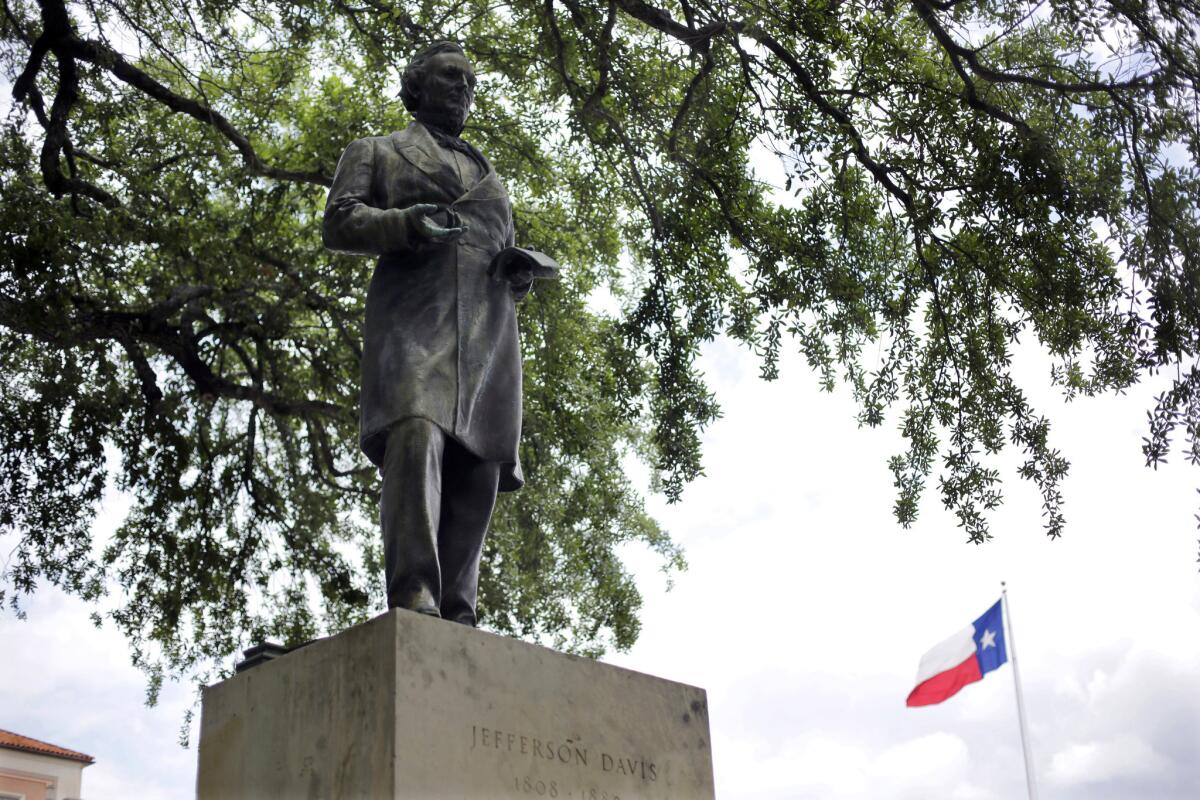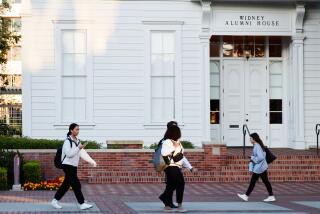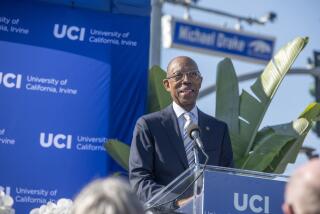Jefferson Davis statue deemed racist to be relocated at UT Austin

A statue of Confederate leader Jefferson Davis in the center of the University of Texas at Austin will be moved to an educational exhibit at the school’s Dolph Briscoe Center for American History.
Following outcries that it represents the South’s racist past and has no place on state property, a statue of Confederate leader Jefferson Davis at the University of Texas at Austin will be moved, the school’s president announced Thursday.
Greg Fenves, the president of UT Austin, said that the statue will be relocated from its outdoor position on the campus’ Main Mall to the school’s Dolph Briscoe Center for American History, where it is expected to take its place in an educational exhibit.
SIGN UP for the free Essential Arts & Culture newsletter >>
However, four other Confederate statues on the campus grounds will remain in place, including one depicting Confederate Gen. Robert E. Lee.
“While every historical figure leaves a mixed legacy, I believe Jefferson Davis is in a separate category, and that it is not in the university’s best interest to continue commemorating him on our Main Mall,” Fenves said in a letter to the UT community posted online Thursday.
“Davis had few ties to Texas; he played a unique role in the history of the American South that is best explained and understood through an educational exhibit.”
The Davis statue at UT Austin was vandalized in recent weeks with the words “Black Lives Matter” and “Bump the Chumps.” It is one of a number of works of public art around the country depicting Confederate and Southern figures to come under attack in recent weeks after the shooting deaths of nine people in June at a predominantly black church in South Carolina.
The four other statues in question at the UT Austin campus depict Lee, James Stephen Hogg, Albert Sidney Johnston and John Reagan.
Fenves said that the latter three “had deep ties to Texas. Robert E. Lee’s complicated legacy to Texas and the nation should not be reduced to his role in the Civil War.”
Fenves said that his decision is “both respectful of the heritage that is important to many and serves as a poignant display of our nation’s and university’s history.” The statues of Johnston and Lee were also vandalized in recent weeks, after the killings in South Carolina.
The massacre was followed by a national debate over the public display of the Confederate flag on government grounds. Photos emerged of the accused shooter, Dylann Roof, posing with the flag.
“Symbols are important, but we must also press ahead to create substantive change at the university,” Fenves said.
Leaders from UT Austin’s Afrikan American Affairs, a black student organization, didn’t immediately respond to a request for comment.
The university’s decision comes after a task force was convened to consider the future of the sculptures. Fenves said that the task force presented its recommendations to him Monday and that he also heard from various members of the university community, including alumni and the public.
Members of the university’s student government organization recently launched an online petition calling for the removal of the Davis statue from its current place.
“We no longer want to see a statue that glorifies the values of Jefferson Davis, who while leading the Confederacy, owned a plantation with over 100 slaves,” the petition states. “This was a man who led an insurgency against our country, so he is an affront to all Americans.”
Xavier Rotnofsky, president of UT Austin’s student government, said in an interview that “the man who is commemorated, [Davis], was a racist, but he was also traitor who led an insurrection against the U.S.”
He added: “Statues are larger than life -- you look up at them. When you learn history, there are some aspects that should be learned and not memorialized.”
The task force convened to consider the issue had some “spirited debates, but it was very academic and civil,” said Rohit Mandalapu, a member of the task force and vice president of the student body. Results from the task force have been posted online.
In Kentucky, a different statue of Jefferson Davis at the statehouse in Frankfort has caused a ruckus with some legislators calling for its removal. The state’s Historic Properties Advisory Commission voted earlier this month to keep the statue, but this week, House Speaker Greg Stumbo, a Democrat, said he would file legislation to move the work of art, according to a report in the Lexington Herald-Leader.
Other recent controversies surrounding public art depicting Confederate leaders include a recent incident in Georgia, in which the leader of the Atlanta branch of the National Assn. for the Advancement of Colored People called for the removal of the Confederate Memorial Carving on the side of Stone Mountain.
Richard Rose, the president of the Atlanta chapter of the NAACP, has called the public art a “glorification of white supremacy.”
Twitter: @DavidNgLAT
More to Read
The biggest entertainment stories
Get our big stories about Hollywood, film, television, music, arts, culture and more right in your inbox as soon as they publish.
You may occasionally receive promotional content from the Los Angeles Times.







